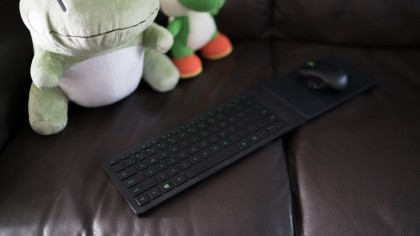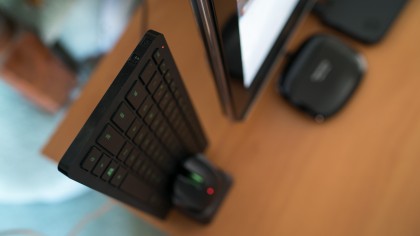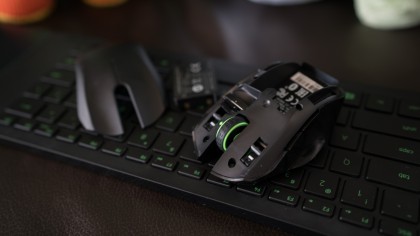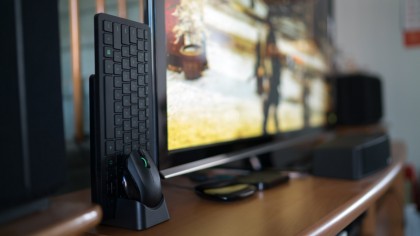TechRadar Verdict
The Razer Turret is a lightweight and wireless alternative to other bulky lapboards, but hardcore PC gamers might not love the feature-light design of this wireless peripheral.
Pros
- +
Sleek wireless design
- +
Compact frame
- +
Convenient charging dock
Cons
- -
Lacks lighting and dedicated macro keys
- -
Weak magnetic mousepad
- -
Small mouse won't work for everyone
Why you can trust TechRadar
Between Steam Machines, small PCs, Steam Link and all the other streaming boxes out there, there are plenty of ways to game from your couch. But to truly game like the rest of the PC master race you need a keyboard and mouse, and Razer thinks its Turret is the perfect wireless solution.
Unlike other lapboards (Roccat's Sova and Corsair's Lapdog come to mind), the $159 (£149, AU$279) Turret is completely wireless and a much thinner device, too. It's little more than a longboard you rest on your lap while gaming on the couch. It's a cleaner and simpler setup than I've seen elsewhere, thoughthe Turret still leaves me longing for more features.

Design
While other lapboards look more like futuristic, oversized bed trays, Razer has taken a much more minimal approach with the Turret. It's easily one of the thinnest keyboards the company has created and it stands in stark contrast to the thick, wedge-shaped living room peripherals that have come before it.
As a result, the Turret has more in common with a laptop keyboard, right down to the chicklet keys. The keys are tactile enough for gaming and comfortably navigating around Windows 10. However, you probably don't want to type out a 1,000-page dissertation on this peripheral – or while staring at your TV for hours.
The shallow keys may not please all, especially gamers who swear by mechanical boards.

You can also forget about dedicated macro keys, media controls beyond programmed shortcuts and even a backlight for the keyboard. The last omission seems uncharacteristic, given everything Razer has released in the last year lights up with an assortment of colors including its wickedly thin Blade Stealth Ultrabook.
On the plus side, the Turret's thin and lightweight build makes it portable rather than anchoring you to the couch like other bigger, wired solutions. I can easily toss my whole peripheral setup aside in case I need to get a drink (or, you know, a bag of Cheetos).

Aside from being extra thin, unlike other lapboards, the Turret also isn't built as one solid piece of plastic. Instead, you can fold away the mousepad, which makes it small enough to slip into a laptop bag while also revealing a set of metal contacts that correspond with its charging cradle.
Though this arrangement might sound flimsy, the peripheral feels sturdy when you have it open and ready for action. The thick rubber underside of the Turret also helps you keep it firmly on your lap.

Magnetic interference
Unfortunately, I can't say the same thing about keeping the mouse firmly planted on the mousepad. With only a thin coating of soft-touch paint and magnets to keep the included mouse in place, it slips off regularly at angles greater than 20 degrees.
The mouse itself is also nearly as small as something you would travel with. The bantam frame demands petite hands or an aggressive claw grip to even move the cursor around. Personally, I had no problems using the mini-mouse, but those with larger mitts might find it infuriating.
One simple solution would be to substitute the Turret's included mouse with something more substantial. Unfortunately, that's impossible as the magnetic pad ends up interfering with the optical and laser-based sensor on other peripherals. So, you're pretty much left to using the Turret's micro-sized mouse.

Wireless transmission
Of course, the ultimate deciding factor on whether Razer's wireless lapboard works is whether it introduces latency, and I'm glad to say it doesn't.
Whether I was connected directly to a gaming laptop parked on my coffee table or a Steam Link streaming my desktop PC, aiming and character movement felt instantaneous. Aside from my terrible driving, the Turret even did a stellar job as I tried to tackle a hill climb in Dirt Rally.
The 2.4GHz wireless connection (and an alternative Bluetooth mode) is fairly strong so long as you're not more than six feet away from the wireless dongle. It also helps if the USB 3.0 port you have the dongle plugged into is pointing towards you. And in case you can't line up direct line of sight between your PC or streaming machine, an extension cable is included in the package.
You won't have to charge it often either, as Razer claims the keyboard has a four-month battery life, while the mouse can run for 40 hours on a single charge. We weren't able to confirm these numbers in our week and a half of testing, but it's easy to keep the two peripherals topped off simply by dropping them into the charging dock

Final verdict
In many ways the Razer Turret is an appealing lapboard thanks to its thinner, lighter and completely wireless design. Rather than having to deal with a mess of tangled wires or an oversized peripheral tray, it actually blends in well with your entertainment system. It's an attractive addition that neatly folds away and plugs into a convenient charging dock – and it works reliably, too.
However, as attractive as it is, the Razer Turret won't work for all gamers. If the lack of mechanical keys and a petite mouse are turn offs for you, it might be worth looking into a more accommodating alternative.
Kevin Lee was a former computing reporter at TechRadar. Kevin is now the SEO Updates Editor at IGN based in New York. He handles all of the best of tech buying guides while also dipping his hand in the entertainment and games evergreen content. Kevin has over eight years of experience in the tech and games publications with previous bylines at Polygon, PC World, and more. Outside of work, Kevin is major movie buff of cult and bad films. He also regularly plays flight & space sim and racing games. IRL he's a fan of archery, axe throwing, and board games.

